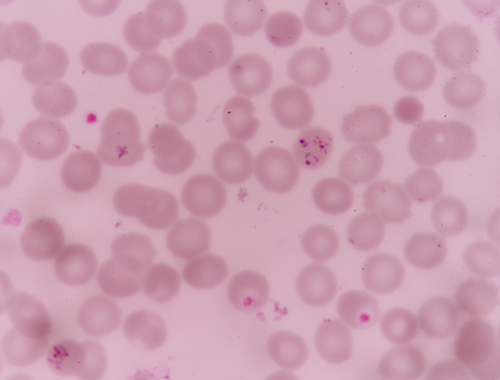Difference Between Plasmodium Falciparum and Vivax
Two of the five most common species that cause malaria include plasmodium falciparum and plasmodium vivax. Plasmodium falciparum is the deadliest specie whereas Plasmodium vivax is the most widespread one.

What is Plasmodium Falciparum?
Definition: Plasmodium falciparum refers to the most lethal species of Plasmodium.
Location: P. falciparum is endemic in tropical and subtropical areas, especially in Africa. It is not found in Europe.
Incubation period: the incubation period of plasmodium falciparum is the shortest, which is 11 days on average. It can vary between 9 to 30 days.
Symptoms: Fever, rigors, chills, and sweating are common symptoms of falciparum malaria. This species is responsible for malignant tertian malaria.
Trophozoite shape: trophozoite shape and size remain the same.
Diagnosis: Thick and thin blood smears are used to identify falciparum species. Other diagnostic tests include rapid diagnostic tests and polymerase chain reactions.
Treatment: Artemisinin-based combination therapies (ACT) are the mainstay treatment for uncomplicated falciparum malaria. Chloroquine is also used in non-resistant cases.
Complications: The most deadly complication of plasmodium falciparum is cerebral malaria. Other complications include acute kidney injury, pulmonary edema, acute respiratory distress syndrome, blackwater fever, hemoglobinuria, and shock.

What is Plasmodium Vivax?
Definition: Plasmodium vivax is the widely spreading malarial protozoan, responsible for causing recurrent malaria.
Location: Vivax is commonly found in Asia, Latin America, and less commonly in Africa.
Incubation period: 10 to 17 days is the average incubation time for plasmodium vivax however this specie can remain dormant in the body for up to 1 year.
Symptoms: Apart from fever and chills, vivax can cause unusual symptoms such as loss of taste, hiccups, dysphagia, and urinary problems.
Trophozoite shape: In plasmodium vivax infestation, trophozoites double up in size and are distorted in shape.
Diagnosis: Rapid diagnostic tests are used to identify vivax species.
Treatment: Uncomplicated vivax malaria is treated with chloroquine and primaquine. Other treatment options include atovaquone-proguanil, quinine plus doxycycline, and mefloquine.
Complications: complications of vivax malaria include cerebral malaria, renal failure, acute respiratory distress, shock, and rarely splenic rupture.
Difference between plasmodium falciparum and vivax
- Definition: Plasmodium falciparum is the most deadly of malaria-causing species whereas Plasmodium vivax is the most rapidly spreading one.
- Location: P. falciparum is common in tropical and subtropical areas of Africa. It is rarely found in Europe. Vivax is commonly found in Asia, Latin America, and Africa.
- Incubation period: the incubation period of plasmodium falciparum is the smallest and varies between 9 to 30 days whereas vivax has an incubation period between 10 to 17 days. Vivax however has an extensive dormancy period of up to 1 year.
- Symptoms: Fever, rigors, chills, and sweating are common symptoms of falciparum malaria. It causes malignant tertian malaria. Vivax can cause unusual symptoms such as loss of taste, hiccups, dysphagia, and urinary problems apart from the usual malarial symptoms.
- Trophozoite shape: Trophozoite shape and size remain the same in falciparum infection. In Plasmodium vivax infestation, trophozoites double up in size and are distorted in shape.
- Diagnosis: Thick and thin blood smears are used to identify both falciparum and vivax species. Other diagnostic tests include rapid diagnostic tests and polymerase chain reaction.
- Treatment: Artemisinin-based combination therapies and chloroquine are used to treat falciparum malaria whereas chloroquine, primaquine, doxycycline, and mefloquine are used to treat vivax malaria.
- Complications: Complications of falciparum malaria include cerebral malaria, acute kidney injury, pulmonary edema, acute respiratory distress syndrome, blackwater fever, hemoglobinuria, and shock. Complications of vivax malaria include cerebral malaria, renal failure, acute respiratory distress, shock, and rarely splenic rupture.
Table of differences between Plasmodium falciparum and vivax

FAQs
How can you tell the difference between Plasmodium vivax and ovale?
Plasmodium vivax when it infects red blood cells causes them to enlarge and have visible granules which are called Schüffner’s dots. Plasmodium ovale trophozoites are more compact.
What are the distinguishing characteristics of Plasmodium falciparum?
Plasmodium falciparum has crescent or sausage-shaped gametocytes. These are bigger than the diameter of a red blood cell.
How can we distinguish the different types of Plasmodium species?
Plasmodium species can be identified under a microscope. Their structure and cell stages are different for different species.
How do you identify Plasmodium vivax?
Vivax gametocyte almost fill the red blood cells and have Schüffner’s dots.
How do you identify P. falciparum?
By their crescent or sausage shaped gametocyte, on microscope.
Is Plasmodium vivax Gram positive or negative?
Since plasmodium is not a bacterium, it does not have a fixed gram stain. Plasmodium vivax may exhibit either gram positive or gram negative stain.
- Differences Between Reptiles and Amphibians - May 17, 2024
- Difference Between Ophthalmology and Optometry - May 15, 2024
- Difference Between Fear and Anxiety - April 2, 2024
Search DifferenceBetween.net :
Leave a Response
References :
[0]Menkin-Smith, Lacey, and Walter T. Winders. "Plasmodium vivax malaria." StatPearls [Internet]. StatPearls Publishing, 2021.
[1]Zekar, Lara, and Tariq Sharman. "Plasmodium falciparum malaria." (2020).
[2]Snow, Robert W. "Global malaria eradication and the importance of Plasmodium falciparum epidemiology in Africa." BMC medicine 13.1 (2015): 1-3.
